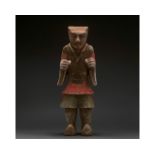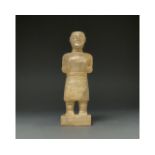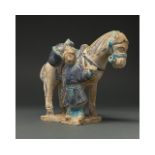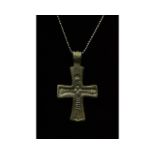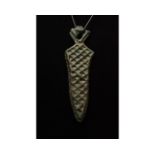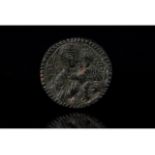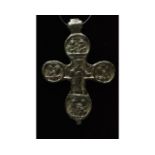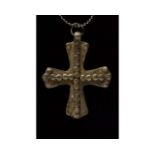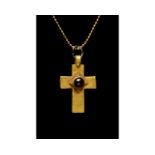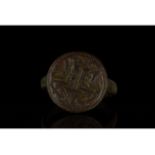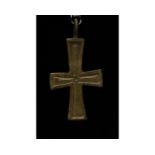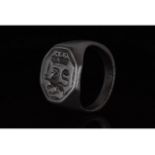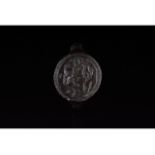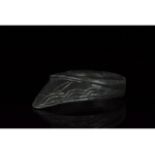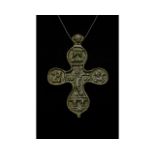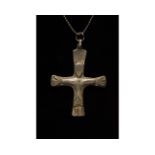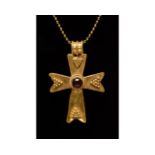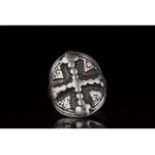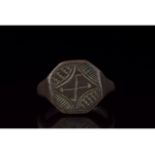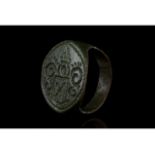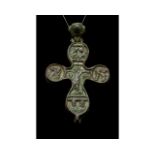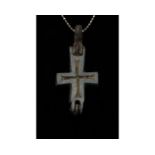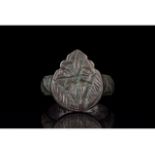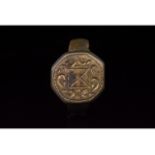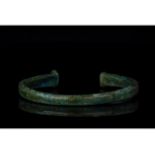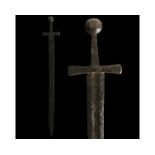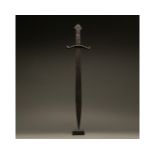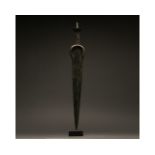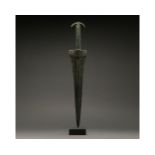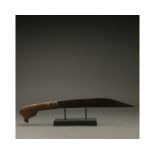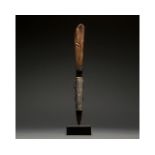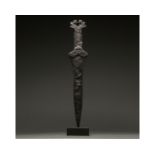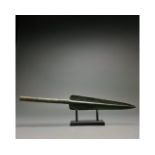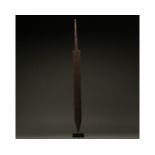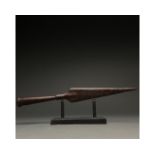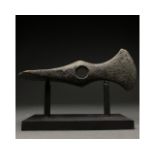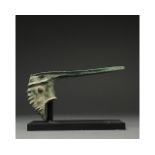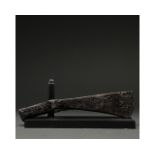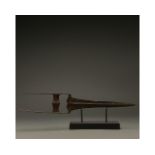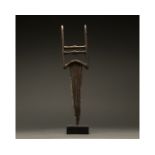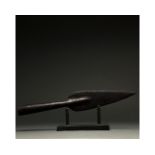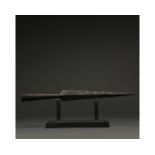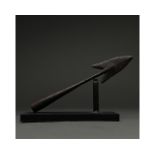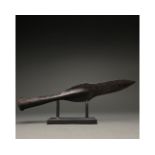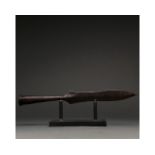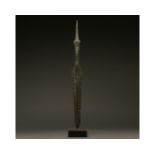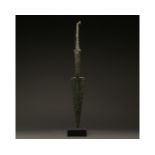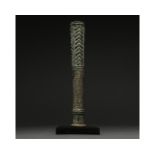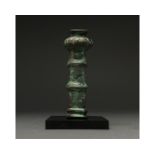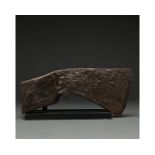Refine your search
Filtered by:
- Category
- List
- Grid
A subscription to the Price Guide is required to view results for auctions ten days or older. Click here for more information
Ca. 206 BC-220 AD Chinese Han Dynasty, terracotta warrior figure. Interesting ceramic figurine of a standing warrior with armor, cross-over war-co...
CA. 200 AD. Western Asiatic. Beautiful cream alabaster figurine of a standing male. The figure, who wears a loose tunic, holds his hands by his si...
Ca. 1368-1644 AD. Chinese Ming Dynasty. Ceramic. This figurine shows a groom, dressed in a dark blue tunic, with light blue trim, a light blue bel...
1000-1500 AD, Crusader Period. Bronze cross pendant with a circular ribbed suspension loop, tapering arms and a stylised, abstract depiction of Je...
Ca. 700-1100 AD. Viking Age. A bronze pendant in the shape of sword comprising an openwork triangular pommel, short handle lozenge-shaped blade wi...
C. 1000-1500 AD. Crusaders period. A bronze, disk-shaped medallion with scalloped edges depicting the Virgin Mary holding an infant Jesus in an ab...
1000-1500 AD, Crusader Period. A large bronze cross pendant with suspension loop and rounded arms; the cross bears extensive relief decoration on ...
1000-1500 AD, Crusader Period. Beautiful silver cross pendant with suspension loop and rounded arms; the cross bears extensive relief decoration, ...
1000-1500 AD, Crusader Period. A beautiful gold pendant in the form of a Latin cross, with a central garnet cabochon flanked by applied baubles; t...
1100-1300 AD, Medieval. Ring with D-shaped hoop and flattened, round bezel featuring incised decorationof two facing dragons. Dragons are an impor...
CRUSADERS ERA BRONZE CROSS
1000-1500 AD, Crusader Period. Bronze cross pendent with suspension loop. Engraved detail on the obverse depicts a smaller cross centered on a sma...
1100-1300 AD, Medieval. Bronze ring with D-shaped hoop and flattened, octagonal bezel featuring incised decorationdepicting a lion holding a sword...
1100-1300 AD. Medieval. Bronze ring with D-shaped hoop and flattened, circular bezel featuring incised decoration depicting a a wolf and a dragon....
MEDIEVAL BRONZE ARCHERS RING
C. 1000-1500 AD. Crusader period. A bronze archer’s ring comprising a circular hoop and projecting triangular guard bearing an engraved floral m...
1000-1500 AD, Crusader Period. A large bronze cross pendant with suspension loop and rounded arms; the cross bears extensive relief decoration on ...
1000-1500 AD, Crusader Period. Silver cross pendant with suspension loop and tapering arms featuring a stylised figure of Jesus during his crucifi...
1000-1500 AD, Crusader Period. Gold pendant in the form of a Maltese cross with a rounded suspension loop, arms of approximately equal length with...
1100-1300 AD. Medieval. A heavy silver heraldic ring with a drop-shaped hoop and a hexagonal plate bezel with small triangular cutaways. The plate...
MEDIEVAL BRONZE RING WITH LION
C. 1000-1500 AD. Crusader period. A bronze ring with a circular hoop and elliptical bezel, bearing an engraved prancing lion. During the Middle Ag...
1000-1500 AD, Crusader Period. A heavy bronze ring with a D-shaped hoop and Maltese cross bezel; both the shoulders and the cross feature punched ...
1100-1300 AD. Byzantine. A very rare cast silver pendant with gilding comprising a circular hoop around a figural scene. The scene a male figure r...
1100-1300 AD. Medieval. A rare bronze heraldic ring with a circular hoop and round plate bezel bearing an engraved horseman and dog motif. Heraldr...
1000-1500 AD, Crusader Period. A heavy silver ring with a circular hoop, flattened shoulders, and pedestalled, lozenge-shaped plate bezel bearing ...
C. 900-1100 AD. Viking Period. This beautiful bronze torc features a wide, flat neck piece, from which dangle dozens of metallic tassels, and a de...
1000-1500 AD, Crusader Period. Rare gold ring with elegant circular hoop and round plate bezel bearing a niello cross motif, comprising a large ce...
LARGE VIKING BRONZE SWORD AMULET
Ca. 700-1100 AD. Viking Age. A bronze pendant in the shape of sword comprising an openwork triangular pommel, short handle lozenge-shaped blade wi...
MEDIEVAL BRONZE CROSS PENDANT
1000-1500 AD, Crusader Period. A beautiful bronze cross pendant with suspension loop and rounded arms; the cross bears extensive relief decoration...
1000-1500 AD, Crusader Period. A silver ring with a circular hoop, curved plate bezel in the form of a shield; the shield bears an engraved cross ...
1000-1500 AD, Crusader Period. A bronze ring with a circular hoop and octagonal plate bezel bearing an engraved cross within a lozenge-shaped fram...
1100-1300 AD, Medieval. Bronze ring with D-shaped hoop and flattened, round bezel featuring incised decoration depicting a shield with two crossed...
1000-1500 AD, Crusader Period. A large bronze double reliquary cross with suspension loop from which hangs a box in the form of a cross with round...
1000-1500 AD, Crusader Period. A bronze double reliquary cross with suspension loop from which hangs a box in the form of a cross with rectangular...
1000-1500 AD. Crusader period. A silver heraldic ring with a circular hoop with a raised circular boss at the bottom and a shield-shaped plate bez...
1100-1300 AD, Medieval. Bronze ring with D-shaped hoop and flattened, octagonal bezel featuring incised decoration depicting a geometric coat of a...
ROMAN BRONZE ARMILLA BRACELET
C. 100-300 AD. Roman. A heavy bronze armilla bracelet with rectangular section and sub-elliptical terminals. Armillae were armband-style bracelets...
VIKING IRON SWORD WITH HANDLE
700-1000 AD. Viking age. An iron sword with a long, doubled-edged blade, culminating in a point and a wide, broad, tapering guard and circular pom...
1100-1300 AD. Medieval European. Iron short sword, with a bevelled, pointed blade, curved guard, rectangular guard and triangular pommel. Sword sw...
1200-700 BC, Greek Archaic Period. This beautiful cast bronze sword has a tapering, bevelled blade, with a raised central midrip, and a an elabora...
ANCIENT BRONZE SWORD ON STAND
1200-700 BC, Greek Archaic Period. This beautiful bronze sword has a tapering, bevelled blade with raised midrib, an integral handle with incised ...
C. 900 AD. Viking age. A medieval Scandinavian pointed knife with a straight blade; expertly cleaned and conserved with a hand-carved, reconstruct...
C. 900 AD. Viking age. A medieval Scandinavian pointed knife with a straight blade; expertly cleaned and conserved with a hand-carved, reconstruct...
c. 323-31 BC. Greek Hellenistic period.This beautiful iron sword has a tapering, bevelled blade with an inverted heart-shaped guard and an integra...
800 – 600 BC. Greek Hoplite Period. Socketed Bronze spearhead comprising a substantial leaf-shaped, lentoid-section blade with raised midrib, in...
RARE ROMAN IRON GLADIUS SWORD
C. 100-200 AD. Roman. An iron Pompeii type gladius blade with parallel cutting edges, a triangular tip and a long tang. The gladius was a key part...
1400-1500 AD. Late medieval. Iron spearhead with traingular head, terminating in a narrow point, narrow cheek, flaring neck and circular socket. G...
BRONZE AGE ADZE AXE HEAD
2000-700 BC, Luristan culture. Bronze axe head with a short, curved blade, a long, tapering cheek, and a wedge-shaped butt. Bronze weaponry produc...
BRONZE AGE DECORATED BATTLE AXE
C. 2000-700 BC. Bronze Age. A bronze battle axe with an elongated, spiked blade, rounded socket and reinforced, flanged butt, bearing a highly abs...
VIKING IRON BATTLE AXE HEAD
c. 900-1100 AD. Viking age. An iron axe head with a short, narrow blade, elongated head, circular socket and short butt. The era known as the Viki...
MUGHAL IRON KATAR DAGGER
C. 1600 – 1800 AD. Post-medieval. An iron Katar dagger or knuckleduster comprising a single, wide, bulging grip and leaf-shaped blade with a pro...
MUGHAL IRON KATAR DAGGER
C. 1600 – 1800 AD. Post-medieval. An iron Katar dagger or knuckleduster comprising a two-part, bulging grip with guard decorated with incised de...
C.800-1100. Viking Age. Iron spearhead with leaf-shaped blade and gently flaring circular socket. Spears were an important component of Viking mil...
C. 100–300 AD. A socketed iron spearhead comprising a triangulat blade with raised midrib. Spearhead of this type were a key part of the Roman c...
ROMAN IRON PILUM SPEAR
C. 100-300 AD. Roman. An iron pilum spear head with a barbed, triangular blade, and a long, narrow neck, and a robust flaring socket. Pila were a ...
MEDIEVAL VIKING AGE IRON SPEAR
C.800-1100. Viking Age. Iron spearhead with a squat lanceolate blade with flaring shoulders and a circular socket. Spears were an important compon...
MEDIEVAL VIKING AGE IRON SPEAR
C.800-1100. Viking Age. Iron spearhead with a lanceolate blade with flaring shoulders and a circular socket. Spears were an important component of...
1200-700 BC, Greek Archaic Period. Bronze Age. A bronze spearhead with a leaf-shaped, lentoid sectioned blade, a wide raised midrib and a long, ge...
1200-700 BC, Greek Archaic Period. Bronze Age. A bronze spearhead with a leaf-shaped, lentoid sectioned blade, a wide raised midrib and a long, ge...
BRONZE AGE DECORATED MACE HEAD
2000-700 BC, Luristan culture. A cast bronze mace head with a tubular shape. The mace head is decorated with 11 rows of raised chevrons, separated...
BRONZE AGE DECORATED MACE HEAD
C. 2000-700 BC, Luristan culture. A Luristan cast bronze mace head with a tubular shape and a protruding, compressed spheroid midsection. The uppe...
VIKING IRON BATTLE AXE HEAD
c. 900-1100 AD. Viking age. An iron axe head comprising a short blade, elongated, downward-angled check and poll with a rounded socket. A small ho...

